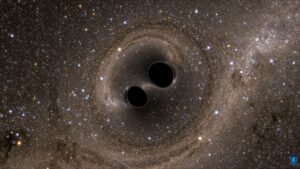For the final assignment of her science journalism course, fourth year Northwestern journalism student Katie Liu was inspired to speak to CIERA Director Dr. Vicky Kalogera about her work with gravitational waves and love for the cosmos. The article below was published in Helix magazine on June 26, 2023.
The universe chirped on a Monday.
The first indication that astronomical history had been made came in the form of emails piling in Dr. Vicky Kalogera’s inbox. Kalogera, a professor of physics and astronomy at Northwestern, was also a leading astrophysicist of an international group of scientists known as the Laser Interferometer Gravitational Wave Observatory (LIGO) Scientific Collaboration. They were chasing after an elusive aftereffect of colliding black holes and dead stars, known as gravitational waves. Albert Einstein predicted their existence over a century ago, but such phenomena were long thought impossible to detect.
It was September 14, 2015. LIGO detectors had just turned on following several years of instrument upgrades and renovations. That Monday was also packed for Kalogera, as she juggled hours of back-to-back meetings.
Communication zipped back and forth as she checked her phone every now and then. There was something about a signal. Kalogera was convinced, however, it had to be yet another system test – extra insurance to check that the detectors were working properly. With that in mind, she went on to pick up her then-three-year-old from daycare and headed home.

As she was setting up dinner, one of her graduate students pinged her with a text.
“Have you looked at our emails today?”
Yes, Kalogera replied, she had. “Are we testing? Is this a signal? What are we doing?”
“We got a signal.”
No way, she thought.
It wasn’t a denial out of awe, but practicality. The observing run was just about to begin. It could not possibly be an actual detection.
Over a Skype call later that night, she and her student ran over the codes responsible for analyzing LIGO data. The measurements looked real enough, both clean and beautiful.
“‘I’m so happy, your code is working so well. We’re ready for the observing run – but there’s no way this is a real signal. It must be a test,’” she recalls telling him, laughing now. “‘Now, don’t spend the whole night up. Go to bed, and we’ll talk tomorrow.’”

Credit: SXS/Caltech
The days and weeks following the signal consisted of hours upon hours of work, simulations, and flurries of teleconferences with the hundreds of collaboration members around the world. All the analysis and consulting across teams and near 24/7 effort was with one thing in mind: check everything that could possibly be checked.
Eventually, they proved what the world now knows. On that day in September, for the first time, humans detected gravitational waves, the remnants of the cosmic catastrophe of two black holes colliding to form a bigger one. What Kalogera had dedicated years of her life to studying and analyzing, and what Einstein had predicted exactly 100 years ago at the time, was finally confirmed.
Read the full Helix article here.
Helix is an independent website that promotes understanding science, exploring research, and expanding opportunities for science writing for scientists and journalists. Currently run by editors and writers from Northwestern University’s The Graduate School and Medill School of Journalism, Media, Integrated Marketing Communications, Helix was originally founded by Science in Society, a Northwestern research center for science outreach and public engagement.

